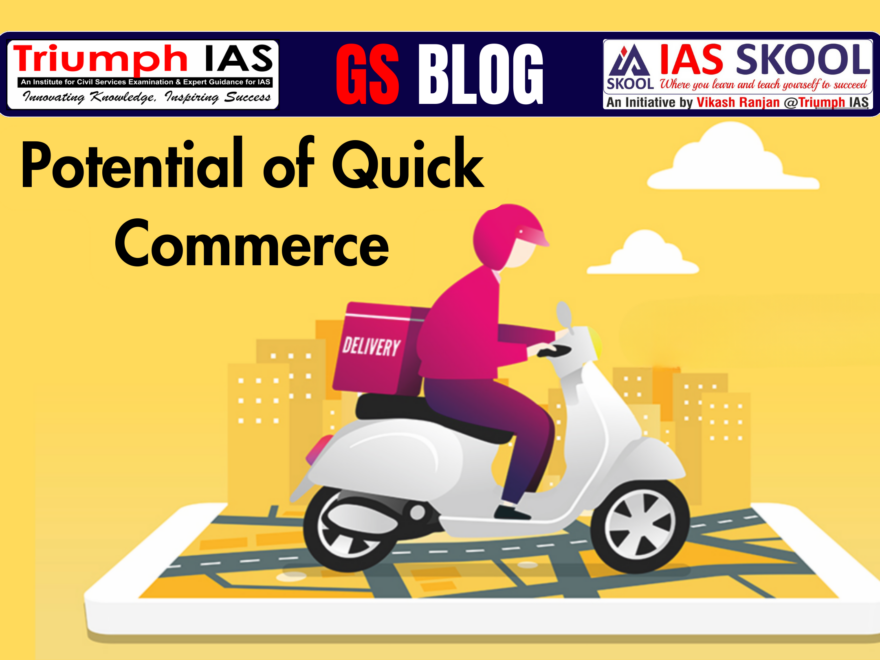Potential of Quick Commerce
India’s e-commerce landscape is undergoing a significant transformation with the rapid rise of quick commerce, a revolutionary shift in the retail sector. While established giants like Amazon and Flipkart continue to dominate traditional e-commerce, companies such as Zepto, Blinkit, and Dunzo are making their mark by catering to the demand for instant delivery. However, their swift growth and aggressive market strategies have attracted regulatory attention, with concerns raised by the Confederation of All India Traders (CAIT) over their business practices and potential impact on the market. As India’s e-commerce market is projected to reach $200 billion by 2026, quick commerce is emerging as both an innovation and a disruption, contributing approximately $5.5 billion to this expanding sector.
Key Opportunities Associated with Quick Commerce
Enhanced Urban Consumer Convenience:
Quick commerce addresses the growing demand for ultra-fast delivery in urban areas, catering to consumers with busy lifestyles who prioritize convenience.
With increasing internet penetration and smartphone adoption, platforms like Blinkit, Zepto, and Swiggy Instamart are becoming integral for instant delivery of groceries, medicines, and personal goods.
Post-COVID-19, the sector has become a vital part of the urban retail ecosystem, meeting the demand for rapid services.
India’s internet user base is expected to surpass 900 million by 2025, with rural areas contributing significantly to this growth and driving overall e-commerce demand.
Boost to Employment Generation and the Gig Economy:
The quick commerce boom is creating substantial employment opportunities for delivery personnel and micro-warehouse staff, while also strengthening the gig economy.
It offers flexible earning opportunities, allowing individuals to take on part-time or night-shift work to supplement their income.
According to NITI Aayog’s report, India’s gig workforce is projected to reach 23.5 million by 2029-30, accounting for 6.7% of the non-agricultural workforce and 4.1% of total livelihoods.
This growth underscores the sector’s role in providing diverse and flexible earning avenues for workers.
Driving Innovation and Technology Adoption:
Quick commerce fosters technological advancements such as AI-powered demand forecasting, inventory optimization, and route planning.
Companies are adopting innovative models, including micro-warehouses, dark stores, and predictive algorithms, to ensure rapid order fulfillment.
These efforts align with the Digital India Mission, further accelerating the country’s digital economy.
For example, Zepto utilizes AI and machine learning to optimize inventory and delivery routes, while drone-based delivery pilots are being tested in remote areas.
Additionally, Swiggy Instamart introduced InstaWarmer at CyberHub, Gurugram, offering an engaging experience to combat Delhi’s winter chill.
Expansion into Tier-2 and Tier-3 Cities:
Quick commerce has significant growth potential in Tier-2 and Tier-3 cities, where digital adoption and e-commerce penetration are on the rise.
This expansion helps bridge the gap between urban and semi-urban areas, enabling smaller cities to enjoy the same level of convenience as metro areas.
In 2023, Tier-2 and Tier-3 cities accounted for 60% of India’s overall e-commerce demand, with an expected annual growth rate of 30% by 2025.
Supporting Emergency and Essential Deliveries:
Quick commerce plays a vital role during emergencies by ensuring the instant delivery of medicines, baby products, and other essentials.
During the COVID-19 pandemic, these platforms were indispensable in maintaining the supply of critical goods during lockdowns.
The sector’s ability to provide rapid support during natural disasters or public health crises can further enhance its societal impact.
For instance, during Bengaluru’s 2024 water crisis, Swiggy Instamart partnered with Earth Fokus to deliver water-saving aerators within 10 minutes.
Contribution to the Startup Ecosystem and Investment Growth:
The quick commerce sector is energizing India’s startup ecosystem by attracting substantial venture capital and global investments.
It has emerged as a high-growth sector, with startups achieving billion-dollar valuations and solidifying India’s reputation as an innovation hub.
In 2023, Zepto became India’s 84th unicorn, defying the broader downturn in venture capital funding for startups.
Driving Export of Quick Commerce Expertise:
As Indian quick commerce companies grow, they have the potential to export their business models and expertise to emerging markets in Southeast Asia and Africa.
This expansion could enhance India’s global presence and contribute to the export of Indian technologies and logistics solutions.
Companies like Swiggy and Zomato are already exploring opportunities in these regions, showcasing the sector’s potential for international scalability.
Key Issues Associated with the Quick Commerce Landscape
Worker Exploitation and Unethical Labor Practices:
Delivery riders often face intense pressure to meet ultra-fast delivery deadlines, compromising their safety and well-being.
The gig-based employment model lacks essential labor protections such as social security, insurance, and fixed salaries, leaving workers financially vulnerable.
For instance, a video shared by a delivery agent during Diwali highlighted earning just ₹300 for six hours of work, sparking widespread debate about working conditions in the gig economy, particularly during peak seasons.
In November 2024, Bengaluru traffic police collected ₹30.57 lakh in fines from delivery riders during a crackdown, further underscoring the sector’s challenges.
Protests by gig workers in cities like Bengaluru and Mumbai demanding better pay and benefits reflect growing discontent among the workforce.
Unsustainability of the Business Model:
The quick commerce sector’s reliance on heavy discounts, cash burn, and investor funding raises concerns about its long-term sustainability.
High operational costs, including delivery expenses and customer acquisition, erode profitability, making it difficult for companies to sustain growth.
For example, industry reports suggest Zepto burned through approximately ₹1,200 crore in the last quarter of 2024, averaging nearly ₹400 crore per month.
Despite high valuations, most quick commerce players remain unprofitable and depend on frequent infusions of venture capital to survive.
Impact on Local Kirana Stores:
The rapid growth of quick commerce platforms has negatively affected local kirana stores, which are the backbone of Indian retail.
The convenience, discounts, and ultra-fast deliveries offered by these platforms have caused a significant shift in consumer behavior, reducing footfall and sales for neighborhood shops.
Additionally, small retailers face increased financial strain due to disrupted supply chains and dependency on aggregators for survival.
Strain on Urban Infrastructure and Traffic Congestion:
Quick commerce services place additional strain on already overburdened urban infrastructure.
The increased movement of delivery fleets, particularly during peak hours, contributes to traffic congestion and pollution.
The absence of dedicated delivery lanes or logistics infrastructure exacerbates these challenges.
Cities like Mumbai and Bengaluru, ranked 5th and 10th globally for urban congestion, experience significant inefficiencies due to quick commerce operations.
Environmental Impact of Rapid Deliveries:
The quick commerce model significantly contributes to carbon emissions and packaging waste, primarily due to the reliance on motorbikes and single-use plastics for deliveries.
Despite some initiatives to promote sustainability, such as Zomato and Swiggy’s attempts at plastic-neutral deliveries, widespread implementation has been lacking.
India’s e-commerce transportation generates an average of 285g CO2 per parcel, accounting for 51% of total delivery emissions.
Limited Focus on Tier-2 and Tier-3 Cities:
While quick commerce thrives in Tier-1 cities, it has struggled to gain traction in Tier-2 and Tier-3 cities due to differing infrastructure and demand dynamics.
Challenges such as poor digital penetration, lower disposable incomes, and logistical barriers limit market expansion beyond urban hubs.
For example, while Blinkit operates in 26 cities, 80% of its new dark-store openings occurred in just the top 8 cities.
Consumer Protection Concerns:
The emphasis on speed often results in compromised product quality, with incorrect or damaged items frequently being delivered to customers.
Opaque pricing, hidden delivery fees, and inconsistent refund policies erode consumer trust in the sector.
A recent report revealed that 48% of online shoppers encountered issues with incorrect deliveries, and 20% received fake or counterfeit items at least once in the past year, highlighting gaps in accountability and transparency within the quick commerce ecosystem.

How India Can Effectively Regulate Quick Commerce and the Broader E-Commerce Sector
Strengthen Labor Protections for Delivery Personnel:
The government should enforce fair wages, insurance coverage, and safety measures for gig workers in the quick commerce and e-commerce sectors.
This can be implemented by leveraging the provisions of the Code on Social Security, 2020, which aims to extend social security benefits to gig and platform workers.
Additionally, companies must provide health insurance, accident coverage, and fixed working hours to reduce exploitation and improve workers’ quality of life.
Introduce Delivery Time Standards to Ensure Safety:
Regulating delivery timelines is essential to prevent overburdening delivery personnel and promoting road safety.
The government could mandate a minimum delivery time for non-essential goods to discourage unsafe driving practices and over-speeding.
A collaborative dialogue between regulators and companies can establish realistic timelines that balance customer satisfaction with rider safety.
Enforce Environmental Standards for Sustainable Logistics:
To combat rising carbon emissions and packaging waste, the government should introduce mandates for green logistics.
Quick commerce and e-commerce platforms must transition to electric vehicles (EVs) and adopt eco-friendly packaging under initiatives like the FAME scheme and the Plastic Waste Management Rules, 2022.
Tax incentives and subsidies can encourage firms to set up EV-based delivery fleets and utilize biodegradable materials.
Establish a Centralized Regulatory Authority for E-Commerce:
A National E-Commerce Regulatory Authority should be created to oversee compliance, resolve disputes, and monitor fair practices across the sector.
This body could address issues such as predatory pricing, monopolistic practices, and data protection.
It can also develop clear investment guidelines to prevent unfair market dominance and ensure equitable growth.
Mandate Data Privacy and Consumer Protection Measures:
Stronger data privacy and consumer protection laws are crucial as e-commerce platforms handle vast amounts of customer data.
The Digital Personal Data Protection Act, 2023 must be strictly enforced to regulate data storage, usage, and sharing practices.
Additionally, platforms should ensure transparency in terms and conditions, clear refund policies, and accountability for faulty deliveries.
Introduce a Certification System for Ethical Practices:
The government can launch a certification program to recognize companies adhering to ethical and fair practices in e-commerce and quick commerce.
A “Responsible E-Commerce” label could be awarded to companies meeting labor safety, sustainability, and customer satisfaction standards.
Public recognition or financial incentives tied to this certification would encourage compliance and self-regulation across the industry.
Standardize Grievance Redressal Mechanisms:
The government should mandate a time-bound, standardized grievance redressal mechanism for e-commerce and quick commerce platforms.
Companies must provide transparent escalation processes for resolving issues like late deliveries, damaged goods, and payment refunds.
An independent ombudsman could oversee consumer complaints, ensuring faster resolutions and fostering trust in the sector.
Promote Tier-2 and Tier-3 City Penetration:
Incentives can be provided to quick commerce and e-commerce platforms to expand their reach into Tier-2 and Tier-3 cities.
Linking such expansion efforts with initiatives like PM Gati Shakti could improve logistics and connectivity in rural and semi-urban areas.
This would facilitate equitable growth, reduce urban pressure, and boost local entrepreneurship.
Mandate Transparency in Pricing and Discounts:
To address concerns about predatory pricing, the government should require platforms to disclose the methodology behind their pricing and discount strategies.
Companies should provide a clear breakdown of how discounts are funded, whether through subsidies or retailer contributions.
This measure would ensure fair competition and protect smaller sellers from being undercut.
Support MSME and Local Store Integration:
E-commerce and quick commerce platforms can be mandated to source a percentage of their inventory from MSMEs and local stores.
The ONDC (Open Network for Digital Commerce) framework can facilitate the integration of small businesses into the organized retail ecosystem.
This would ensure fair market access for MSMEs and foster localized economic growth
Quick commerce is transforming India’s retail ecosystem by addressing the demand for instant gratification and unlocking opportunities for innovation, employment generation, and market expansion.
However, issues such as worker exploitation, environmental degradation, and competition with local stores require thoughtful regulation.
To ensure sustainable growth, it is vital to strengthen labor protections, enforce environmental standards, and uphold consumer rights.
The establishment of a centralized regulatory authority, transparency in pricing practices, and efforts to foster equitable growth in Tier-2 and Tier-3 cities can create a fair and balanced quick commerce sector.
The End of the Blog: Potential of Quick Commerce

|



















One comment